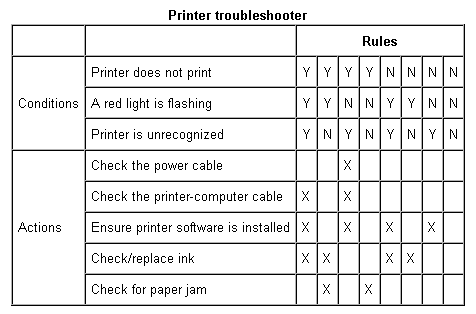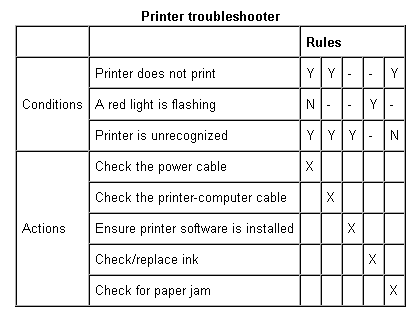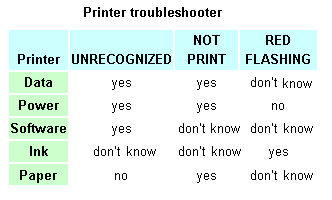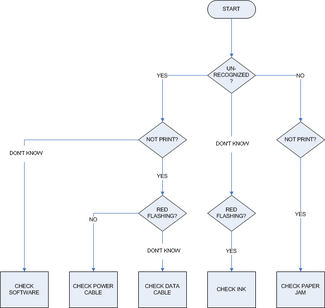Practical Applications
Robot Interface
One practical application may be in the interfacing of robots with humans.
Consider a sensor value as the value of an independent variable in a rule made up of the values of many sensors. In report and diagnostic mode it might be helpful for humans if the robot could verbalize its sensor status. The rule could be reduced to minimum form and provided to the operator as a summary of current sensor status.
For instance, when the rule above defining happiness is used as a template and "oil" is used in the place of "love" and "can move arm" used as the dependent event in place of "happiness", then, when the robot is asked to report when it can move its arm, as the dependent event inquiry the robot, recalling its status in summary for all occasions, would say, "Robot can move arm when lots of oil or some oil."
Admittedly crude but effective nonetheless.
Polychotomous Keys
While robots only need a decision table to provide cognitive functions and artificial neural networks to provide an artificial autonomic nervous system, humans require decision tables to be digested into polychotomous keys. Most professional disciplines, such as law and medicine, have actions and conditions, which can be stated in the form of a polychotomous key. The rules which link conditions to actions can be prepared for optimization by reduction to minimum form.
Developing a Polychotomous Key
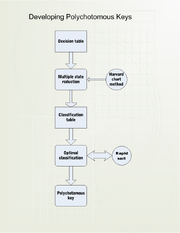
Steps in the development of a polychotomous key
Decision Table
Decision tables may have conditions with multi-valued states, where , in which equals the number of rules, equals the highest number of states, and equals the number of conditions. In the following example with two states and three conditions there are eight rules, . Each action may be associated with a rule by logical conjunction or logical disjunction. Actions associated by logical conjunction will follow the same rule, whereas actions associated by logical disjunction may follow rules whose conditions have ambiguous states in regard to a particular action.
In the example shown below the actions listed are associated by logical disjunction, and follow different rules.
| Action | Rule |
| power cable | 1A0B1C |
| printer cable | 1A1B1C or 1A0B1C |
| software error | 1A1B1C or 1A0B1C or 01A1B1C or 0A0B1C |
| out of ink | 1A1B1C or 1A1B0C or 01A1B1C or 0A1B0C |
| paper jam | 1A1B0C or 1A0B0C |
(Note: Conditions: Printer does not print = A, A red light is flashing = B, Printer is unrecognized = C. States: Yes = 1, No = 0, Don't know = 2.)
Rule Reduction
Since the same action may be indicated by more than one rule with the result of ambiguous states for an irrelevant condition, an additional "irrelevant" state may be added by applying the method of logical equation reduction to consolidate the rules...
| Action | Rule |
| power cable | 1A0B1C |
| printer cable | 1A2B1C |
| software error | 2A2B1C |
| out of ink | 2A1B2C |
| paper jam | 1A2B0C |
...with the result of the irrelevant states being excluded.
| Action | Rule |
| power cable | 1A0B1C |
| printer cable | 1A1C |
| software error | 1C |
| out of ink | 1B |
| paper jam | 1A0C |
Optimization
The order of the conditions may be optimized to produce the minimum number of queries but reversal of the order may be required to produce the best intuitive order.
A more intuitive order, may result from the reverse optimal order as when flashing of the red light on the printer is determined first, followed by whether the printer is printing, followed by whether the printer is unrecognized by the computer.
| printer | not printing | red flashing | unrecognized |
| power | 1 | 0 | 1 |
| data | 1 | 2 | 1 |
| paper | 1 | 2 | 0 |
| ink | 2 | 1 | 2 |
| software | 2 | 2 | 1 |
0 = no
1 = yes
2 = irrelevant
Polychotomous Key
Optimal
More intuitive
Most intuitive?
Note that the most intuitive order of conditions appears to be the reverse of the optimal order.
Checklists
Checklists speed the process of decision making by presenting option boxes for each state of each independent variable which are listed in the optimal or other appropriate order.
Automation
Automation takes the process of decision making one step further by presenting all of the independent variables with an option button for each state. After an option button is selected only the remaining variables and states are presented until all options are gone.





